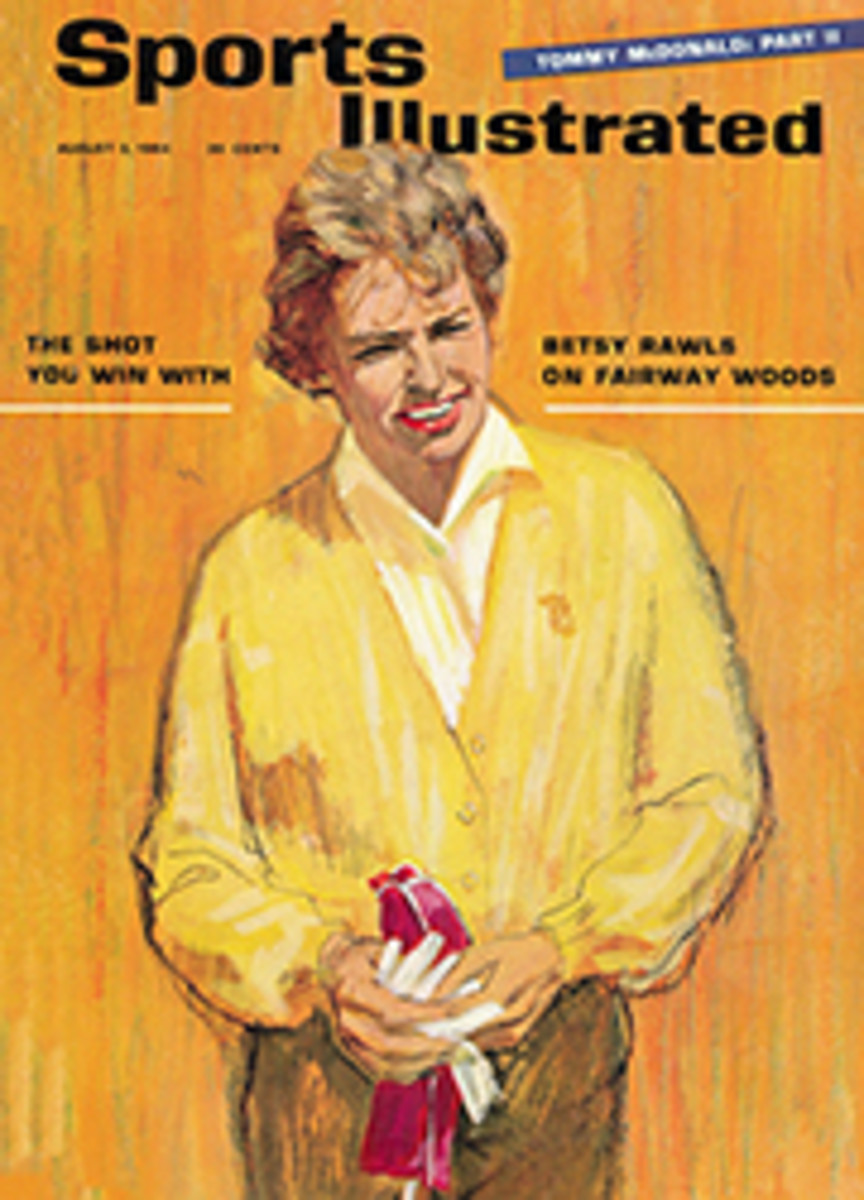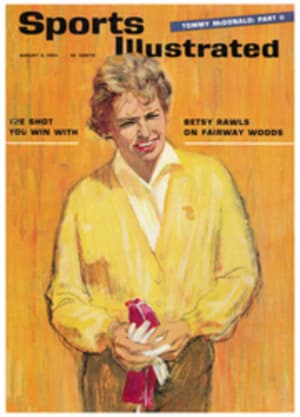
Three Big Banzais and a Tiger for All Sports
With the uncompromising fanaticism of a samurai warrior confronted by a dozen grimacing foes, the people of Japan recently have thrown themselves into a multitude of sports—mainly Western—as eager participants or frenzied spectators or both. As a pleasant economic corollary to this orgy of athleticism, they are manufacturing sports goods for export at a greater clip than ever before and, paradoxically, importing sporting goods at the greatest rate in their history.
Sports are big business and big pleasure in Japan. This is partly due to the fact that the forthcoming Olympic Games have for several months been making a vast impression on the nation as a whole. But the main reason is probably something the Japanese call the reja boomu. Literally translated (and there is no other way to translate it), this means the "leisure boom." The Japanese have more time on their hands and more change in their pockets than ever before. Their traditional zeal, their extra time and extra money have been channeled into sports. Nowhere in the world are athletes more deified, sports spectacles more appreciated or athletics engaged in (on a per-capita basis) by so many.
Majestic Fujiyama, which used to be climbed by some adventurers for athletic and aesthetic reasons, now resembles Tokyo's bustling Ginza, with traffic jams up and down its slopes.
Baseball, bowling and golf—all American or European imports—have made serious inroads on such traditional sports as kendo (dueling with staves) and judo. Sumo is still booming as a spectator sport, but 10 times as many Japanese attend major league baseball games as watch the large perspiring men grapple with each other.
Sport is a 24-hour-a-day, year-round activity in Japan, and the average Japanese puts up with discomforts in the pursuit of his favorite activity that would make most Westerners shudder and take up reading. Last winter, Japan's 10 million skiers produced such mob scenes at bus terminals and railroad depots that rescue squads carrying portable oxygen tanks had to spray oxygen in the air to revive those who found themselves unable to breathe because of the crush.
During summer weekends Japan's beaches look the way Coney Island used to on the Fourth of July. Bathers occupy every square centimeter of sand and, if one can break through the crowds and find the ocean, the usual complaint is that nowhere is there a single clear patch of water to swim in. The Japanese not only bowl in staggering numbers, they jam the lanes to watch bowling.
Baseball, however, is the national sport of Japan. The average rooter among the nine million pro-ball fans is so dedicated to his team that he is likely to follow it as it travels from city to city. It is the well-to-do shopkeeper who seems to be the most ardent baseball fan of all. He and his colleagues, never missing a game, encourage their team by blowing trumpets, beating drums and tootling whistles. He showers tons of confetti on his favorites, or on fans near his favorites. While traveling with his team, the shopkeeper usually deputizes his wife to run the business. One baseball widow has complained, "I don't mind running the store, but I don't like the idea of sitting up all night cutting up confetti for my husband to throw away at the ball park."
The Japanese are influenced in their enthusiasm for a sport by the personal appearances of superstars from the West and by their own successes against Westerners. Golfing took a surge when a pair of Japanese players won the Canada Cup in 1957 and another surge when Arnold Palmer performed in Japan a year ago. A good many of the members of Arnie's Army (Oriental Division) apparently were inspired to take up the game seriously, because the popularity of the game rose markedly thereafter. Now Japan has 318 courses in operation, 42 more being built and scores more in the planning stage. Skiing, in recent years a popular sport in Japan, received additional impetus when Toni Sailer, the handsome triple Olympic-gold-medal winner from Austria, came to Japan to make a movie. Thousands more of Japanese males took up the sport and even more thousands of Japanese young ladies abandoned strumming the samisen and attending Kabuki to learn to wedeln the way Toni did.
Japan, the first Asiatic nation to play host to the Olympic Games, will spend about 700 billion yen ($2 billion) to make sure things go off all right. But to the American sportsman the incredible Japanese fervor for sport is reflected not so much in shiny new stadiums and athletes' barracks in the vicinity of Tokyo as in the low-priced, less-than-top-quality Japanese-made sporting goods that have been flooding the American market.
According to many Japanese, Americans have every right to label imported Japanese sporting goods as second-rate because they are second-rate. An official of the Japanese Ministry of Trade and Industry explains, "We are caught in an economic trap. Our overseas customers do not know about the excellent products we can produce, because at present the principal selling factor is cheapness of price."
Japan's growing pride in her sporting-goods industry, as well as her all-consuming interest in sports, may cause a change in the near future. Kenjiro Mizuno, vice-president of the Mizuno Sporting Goods Co., would like to see Japanese manufacturers concentrate on high quality. "Japan exports only second-rate sporting goods," he points out. "This gives the impression that she can produce only second-rate goods. I feel the time has come for the Japanese sporting-goods industry to produce better-quality products, even if the price is higher." The Japanese themselves do not mind paying high prices if they can get good quality. Mr. Mizuno's company sells 95% of its quality products to the Japanese and is the largest sporting-goods supplier in Japan. If the firm should become seriously involved in exporting its higher-priced goods to America, Mr. Mizuno looks forward to giving major U.S. firms serious competition.
Despite the fact that Japanese manufacturers producing the best-quality sporting goods have not yet gotten both feet into the export business, Japan shipped to the U.S. last year more than $18 million worth of sports equipment—apart from bicycles and motorcycles. In the historic pattern of workshop manufacture, Japanese of both sexes and all ages are parceled out contracts to produce such items of sports equipment as baseball gloves, badminton rackets and fishing lures, and solemnly go to work.
In 1963 three out of five baseball gloves bought in the U.S. were made in Japan. Costing between $5 and $10, they were quite satisfactory for Little Leaguers, sandlotters and for youngsters playing catch with their fathers. The Japanese also shipped to the U.S. 3.5 million tennis and badminton rackets, a quarter of a million tennis balls, 900,000 artificial fishing lures, nearly half a million fishing rods and numerous skis, golf clubs, lacrosse sticks, roller skates, ice skates, croquet sets and balls of just about every size, material and dimension. So satisfying to the Japanese are sales in the U.S. of baseball gloves, badminton rackets and other products that the firms and workshops producing these voluntarily limit themselves to export quotas for fear of drawing down on their heads reprisals in the form of higher tarifis.
That the Japanese can, when they set their minds to it, produce a superior piece of sports merchandise is shown by the electrifying success of the Honda motorcycle. The Honda firm was started in 1948 by Soichiro Honda, a former auto mechanic, who began constructing motorcycles from spare machine parts—generally relics of World War II. Today his motorcycles typify a new excellence in Japanese manufacture that has won him the ungrudging admiration of the Western world.
When Honda introduced his motorcycles into the U.S. in 1959, only 500 machines were sold; last year Hondas swept just about every motorcycle race they entered, from Spain to Finland and all stops in between; and last year 100,000 Hondas were sold in the U.S.—three times the total sales of the firm's 44 competitors. A British motorcycle competitor of Honda, bemused at his failure to defeat the Japanese machine, recently took a Honda racer apart. When he had thoroughly inspected the machine he said, "It isn't a copy of anything. It's made with the precision of a watch, and it's the product of very original thinking." The Honda firm is putting the finishing touches on a sports car designed for Grand Prix racing, and may unveil its efforts at one of the major meets this fall.
But the sporting-goods export business is a two-way street. Because of the current preoccupation of the Japanese with sport and their adulation of Western know-how, U.S. manufacturers of sporting goods have found the Japanese, in turn, to be quite receptive to American products. A.M.F. and Brunswick supply all the equipment for Japanese bowling emporia. Japanese businessmen, like their sporty American counterparts, mix business with the tee ceremony and tend to lose face on the course if they don't waggle a matched set of American-made clubs. Japanese touring the U.S. make it a point to return to Japan with a bagful of American clubs (one set is duty-free), just as the American visiting Japan makes sure to come home with a Nikon camera or at least a kimono.
Japan imported 600 dozen bats from the U.S. last year. According to Shigeo Kibe, editor of an influential Japanese sports magazine, "All pro ballplayers use imported gloves and most use imported bats." The quality of Japanese bats is low because of the brittleness of Japanese hardwood trees. To make matters worse (according to Mr. Kibe), manufacturers hasten the seasoning process, and what emerges has the resistance of a matchstick. Half a dozen broken bats in a single professional game is not uncommon. As a result, Japanese ballplayers, as hard-headed as athletes anywhere, tend to prefer the Louisville Slugger over homemade bats.
Japan's next enthusiasm may be surfing. A party of American surfers, traveling around the world on a map-making tour, recently tried out a number of Japanese beaches. Every time the surfers climbed atop their boards and surged shoreward, buffeted by the waves, the thousands of Japanese lining the beach would rush to the water's edge, leap up and down and shout with excitement. It is not inconceivable that Japan will soon be manufacturing low-priced surfboards for export to the U.S., and American manufacturers, in turn, will be shipping out surfboards for sale to the hippest of Nippon's surfers.
PHOTO
THE VALIANT SAMURAI, astride a Honda motorcycle and outfitted with modern athletic gear, symbolizes Japan's rocketing yen for sports.

